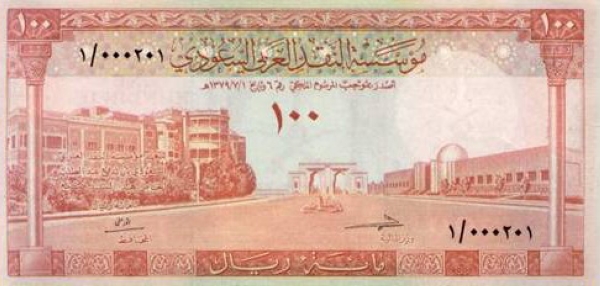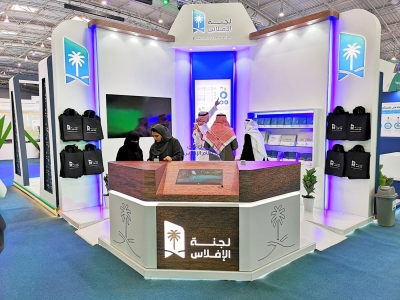





After the unification of Hejaz with Najd in 1925, and by the order of King Abdulaziz Bin Abdulrahman Al Saud, large quantities of copper coins of half qirsh and quarter qirsh denominations were minted. The full name of King Abdulaziz (Abdulaziz Bin Abdulrahman al-Faisal Al Saud) is engraved on its face in Tughra Script, along with the year of minting (1925). The back of the two denominations shows their value and the place of minting; ie; Umm al-Qura (Makkah al-Mukarramah). This issuance, with its two denominations (half-qirsh and quarter-qirsh), marks the first Saudi monetary issuance.
With the market's need for additional quantities of these coins, King Abdulaziz ordered in the same year (1925) the minting of another batch, similar in style to the former ones but with some variation in the way the King's name was inscribed, which appeared as follows: (Abdulaziz Bin Abdulrahman al-Faisal). At the beginning of 1926, King Abdulaziz ordered the minting of another quantity of half-qirsh denomination only. Engraved on the obverse side is the full name of King Abdulaziz without adding any of his titles (Abdulaziz Bin Abdulrahman al-Faisal Al Saud), and at the bottom is engraved the year (2), indicating the second year of King Abdulaziz's rule after the unification of the Hijaz with the rest of his Kingdom. This supports that these copper coins are indeed the first official Saudi coins.
In 1928, King Abdulaziz abolished the use of all circulating coins and ordered the introduction of his new coins bearing his title (King of Hijaz and Najd and Dependencies). They were minted from a (copper-nickel) alloy and included denominations of one qirsh, half qirsh, and quarter qirsh, with designs identical to those of the qirsh and its subdivisions minted in 1925. However, the year of minting (1928) was engraved at the bottom of the coin.
During the same year (1928), King Abdulaziz ordered the release of the first pure Saudi Arabian riyal, made of silver. The riyal and its denominations, including the half riyal and quarter riyal, were uniquely designed, featuring inscriptions and numbers engraved centrally and peripherally. The full name of the King (Abdulaziz Bin Abdulrahman Al Saud) was inscribed inside a circle at the center of the obverse side. The margin included his title (King of Hijaz and Najd and Dependencies) and the state emblem of two crossed swords within a semi-rectangular shape, with two palm trees engraved beside it. As for the reverse side, the center featured the place of minting and its date (Struck in Makkah al-Mukarramah 1928), while the margin included the value in both letters and numerals.
Also in the year (1928), King Abdulaziz issued his Royal Order which included the first monetary regulation in the country, published in the official gazette 'Umm al-Qura' in its issue number (160), dated January 9, 1928. With the issuance of this monetary law, it became mandatory for everyone to transact in SAR, and other currencies were abandoned. This necessitated the reminting of the riyal once again in 1930, in all its denominations and according to its previous specifications, except for the minting year (1930). It was circulated according to the exchange standard of the Hijazi-Najdi piasters, which were also reminted during that year in all their denominations, following their previous specifications except for the minting year (1930).
After King Abdulaziz Bin Abdulrahman unified the country, Royal Decree No. 2716 was issued on September 22, 1932, transforming the country from the Kingdom of Hijaz and Najd and Dependencies to the Kingdom of Saudi Arabia. It was decided to use the title (King of the Kingdom of Saudi Arabia) instead of (King of Hejaz and Najd and Dependencies). However, this title did not appear on the coins until 1935, when the first Saudi currency carrying the new name of the state after its unification was introduced. This was on the new silver riyal and its denominations, including the half riyal and quarter riyal.
King Abdulaziz was keen on establishing a national bank responsible for issuing Saudi currency. Thus, the Saudi Arabian Monetary Agency 'SAMA', (currently the Saudi Central Bank), was established. It is the second oldest central bank in the Arab world. It commenced operations on October 4, 1952, headquartered in Jeddah. Its initial tasks included issuing the Saudi gold pound and completing the minting of silver riyals. It worked on minting the silver riyal bearing the name of King Abdulaziz in 1953. Consequently, the country's currency began to be issued by a Saudi national institution. Additionally, what was known then as Pilgrims Receipts were issued for circulation starting from July 25, 1953, in denominations of SAR10. This was to facilitate pilgrims due to the difficulty of carrying metallic coins. Five million receipts were printed as the first edition. These receipts contained inscriptions in multiple languages, preserving the value of the receipt holder's Saudi silver riyals.
With the relocation of the main headquarters of the Saudi Arabian Monetary Authority from Jeddah to Riyadh on July 7, 1959, the first issuance of official paper currency was authorized under the Currency Law issued by Royal Decree during the reign of King Saud Bin Abdulaziz Al Saud.
Related quizzes

